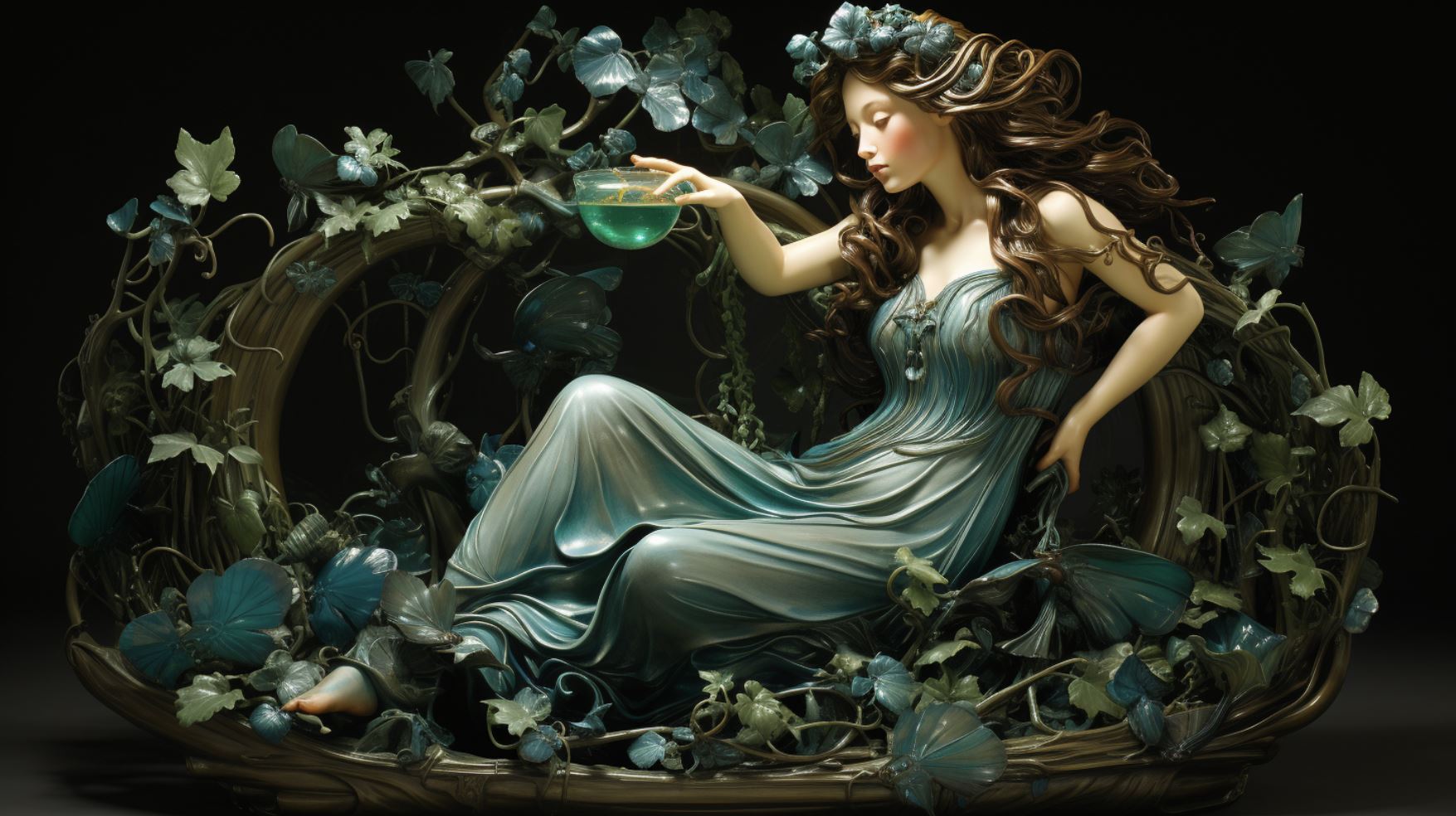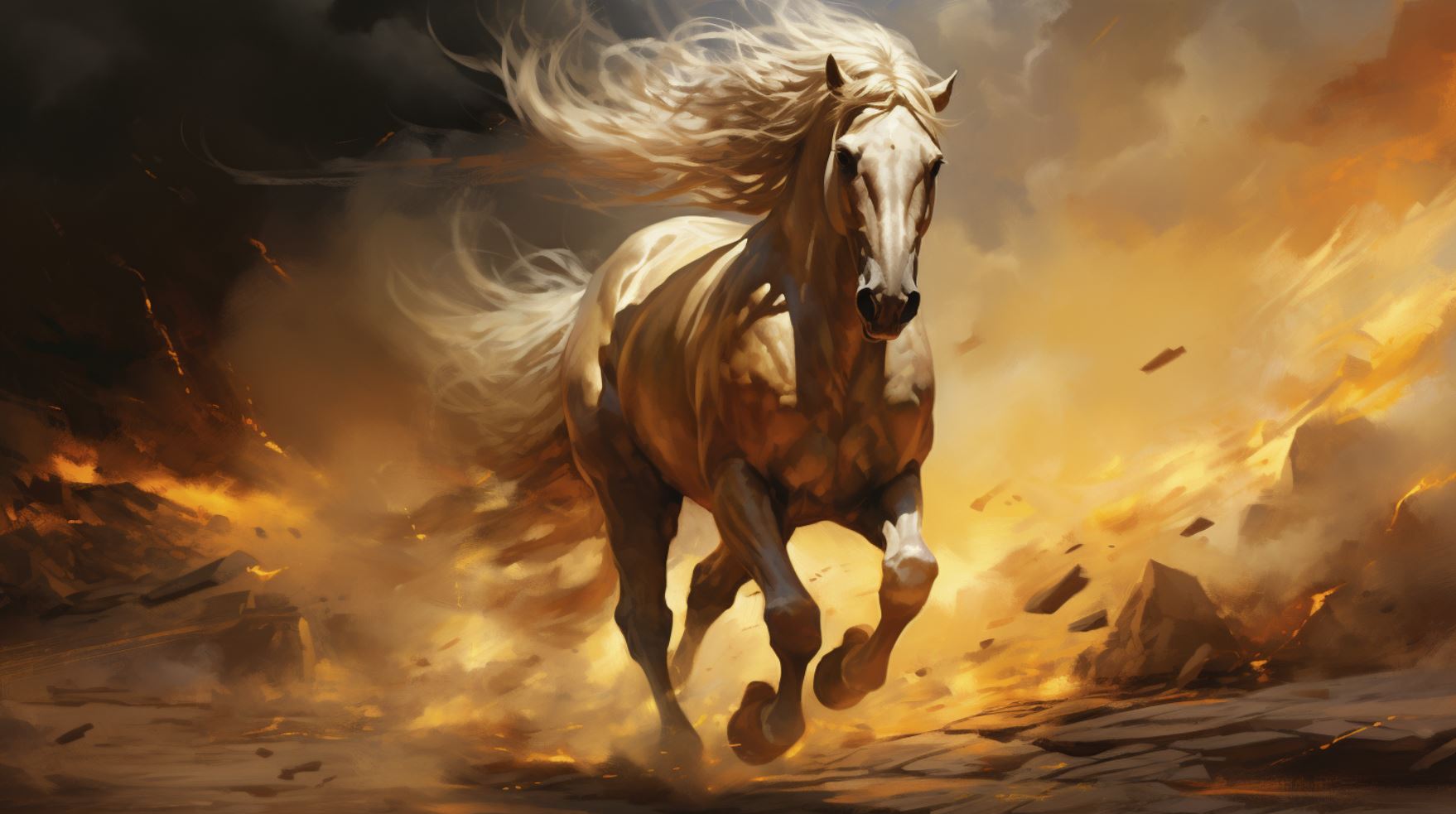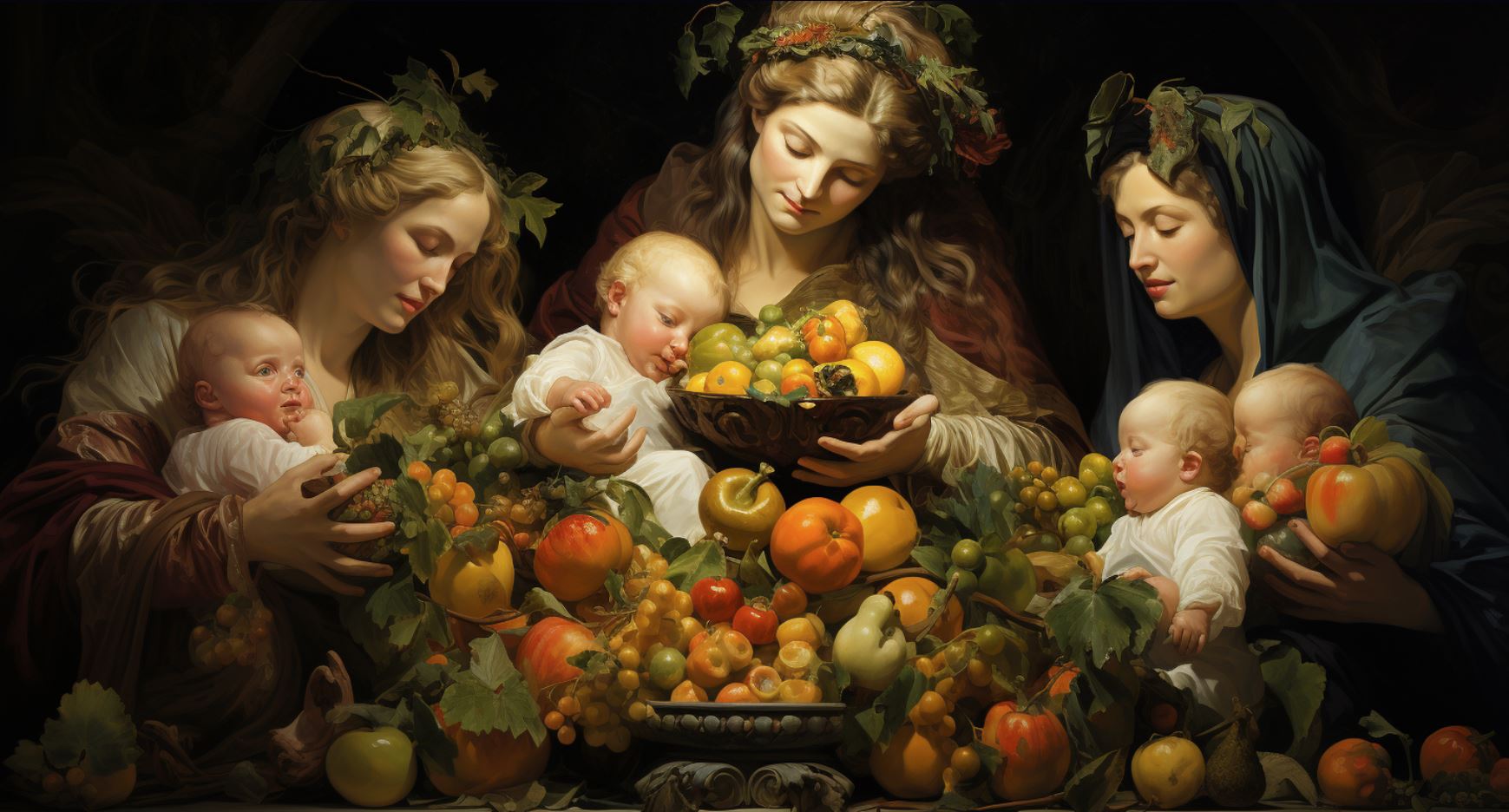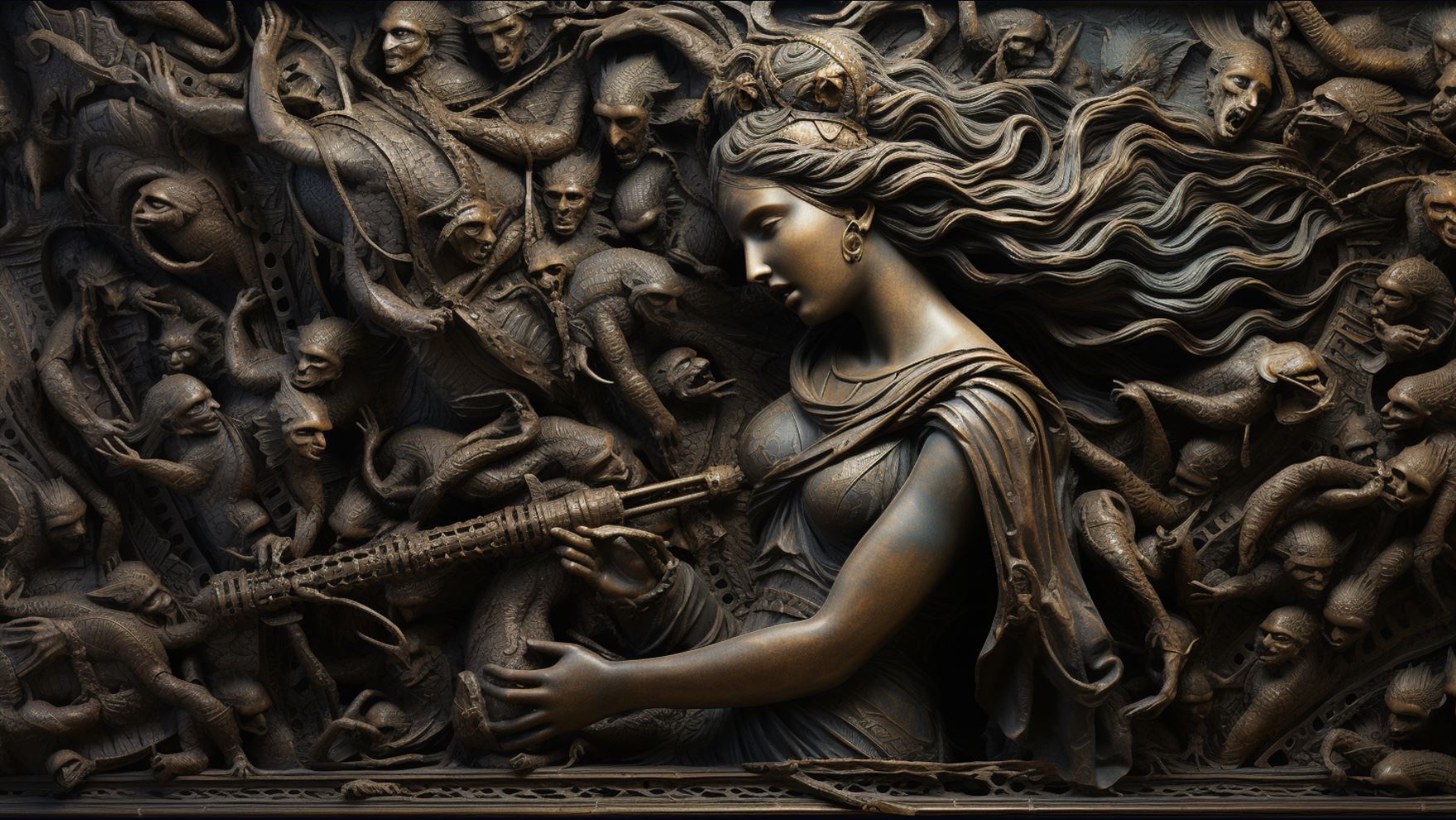Coventina Goddess: Exploring the Sacred Waters and Mysteries of the British Celtic Deity

Coventina Goddess is a prominent figure in British Celtic mythology, revered as the deity of sacred water sources. She is often depicted as a water nymph, gracefully floating on a leaf while holding vessels filled with water.
Coventina represents healing, renewal, abundance, and new beginnings, and is associated with prophecy, inspiration, and divination. In the context of Druidism, Coventina holds an important place, intertwined with the roles of Bardos, Ovates, and Druids.
This article explores the origins, symbolism, offerings, and practices associated with Coventina, offering a deeper understanding of her significance in the Druidic traditions.
Origins and Mythology of Coventina
The origins of Coventina and her mythology date back to ancient British Celtic traditions. She is revered as a powerful goddess associated with sacred water sources, often depicted as a water nymph gracefully floating on a leaf, carrying vessels filled with the purest water.
Coventina holds a significant place in Celtic folklore, symbolizing the life-giving and renewing properties of water. She is believed to possess immense healing powers, offering solace and rejuvenation to those who seek her divine presence.
Throughout the centuries, Coventina’s name has been invoked in numerous rituals and ceremonies dedicated to celebrating the cycles of life, abundance, and fertility. Her association with water springs, wells, and fountains establishes her as a guardian of these sacred sites, blessing them with her presence.
Legends speak of the reverence and offerings made to Coventina, ranging from pins, votive objects, coins, to semi-precious stones. These offerings were believed to connect individuals with Coventina’s magic and bring about their desires, prophecies, and aspirations.
The rich mythology surrounding Coventina reflects her profound influence in the realms of healing, inspiration, and prophecy, making her an integral part of both Celtic and Druidic traditions.
Symbolism and Representation of Coventina
Coventina, the British Celtic goddess of sacred water sources, holds deep symbolism within Druidic traditions.
She is often portrayed as a graceful water nymph, gracefully floating on a leaf while holding vessels filled with water. This representation signifies her connection to the element of water and its life-giving properties.
Coventina’s presence in these sacred waters represents the flow and cycles of life, renewal, and healing.
Furthermore, the objects associated with Coventina, such as pins, votive offerings, coins, and semiprecious stones, hold symbolic significance. Each of these offerings represents a token of appreciation or a desire for a specific outcome.
These items act as conduits for sympathetic magic, enhancing the power of intentions and desires expressed during worship.
Coventina’s symbolism extends beyond her physical representation. She embodies aspects of fertility, abundance, inspiration, and prophecy. Her association with healing and renewal makes her a prominent figure in rituals and practices aimed at physical and spiritual well-being.
Through offerings and rituals dedicated to Coventina, individuals seek her guidance, protection, and blessings for new beginnings and the fulfillment of their desires.
Understanding the symbolism and representation of Coventina allows practitioners of Druidism to connect deeply with her divine energy and wisdom, fostering a harmonious relationship with water, nature, and the cycles of life.
Sacred Water Sources and Coventina’s Associations
In the realm of Coventina Goddess worship, the significance of sacred water sources cannot be overstated. These natural springs, wells, and bodies of water hold a deep connection to Coventina’s essence and embody her divine presence.
It is believed that these water sources hold immense healing and purifying powers, making them ideal places for offerings and rituals.
Coventina’s associations with sacred water extend beyond mere physicality. Water, in all its forms, symbolizes the cycles of life, cleansing, and renewal. As the goddess of these sacred waters, Coventina acts as a conduit for spiritual and physical healing, guiding individuals through transformative experiences and assisting in their personal growth.
Her associations with water also bring forth her connection to the natural world and its intricate ecosystems. Coventina is often revered as the protector of freshwater creatures and their habitats.
Through her worship, practitioners seek to honor and preserve the delicate balance of nature.
Offerings such as pins, votive offerings, coins, and semi-precious stones are made to Coventina at these sacred water sources. These acts of reverence and gratitude aim to establish a harmonious relationship with the goddess and seek her blessings in various aspects of life, ranging from fertility and abundance to inspiration and prophecy.
Common Offerings and Rituals for Coventina
When honoring Coventina, devotees often make various offerings to express their reverence and seek her blessings. These offerings are centered around the theme of water, reflecting her association with sacred water sources.
Here are some common offerings that are traditionally presented to Coventina:
- Pins and votive offerings: Devotees offer small pins or votive objects to Coventina as symbols of their reverence and gratitude.
- Coins: Ancient coins, especially those depicting water-related motifs, are frequently presented to Coventina.
- Semiprecious stones: Stones with a connection to the water element, such as aquamarine or moonstone, hold special significance and are offered to Coventina.
In addition to offerings, rituals play an integral role in Coventina worship.
These rituals aim to connect with her energies and invoke her blessings. Some common rituals associated with Coventina include:
- Water libations: Devotees pour water into a sacred vessel, symbolizing the act of offering to Coventina.
The water is then poured back into a natural water source as a gesture of returning the essence.
- Bathing rituals: Individuals immerse themselves in natural water sources, such as springs or rivers, to cleanse and purify themselves while invoking Coventina’s healing and renewal powers.
- Divination ceremonies: Practitioners may seek Coventina’s guidance and prophetic insights through divination practices such as scrying or tarot readings focused on water-related symbolism.
These offerings and rituals serve as a means of establishing a deeper connection with Coventina, seeking her blessings for healing, renewal, and guidance in one’s personal and spiritual journey.
The Healing and Renewal Powers of Coventina
Coventina, the British Celtic goddess of sacred water sources, possesses powerful healing and renewal abilities. As devotees immerse themselves in the enchanting waters associated with Coventina, they tap into her transformative energy to cleanse, rejuvenate, and heal both the body and the spirit.
The waters blessed by Coventina are believed to possess restorative properties, providing physical and emotional healing to those who seek solace within their depths. Through rituals and offerings, followers of Coventina can invoke her healing powers and attain a renewed sense of well-being.
Coventina’s influence extends beyond physical healing. She facilitates deep emotional and spiritual renewal, offering guidance and support during times of transformation. Her mystical waters not only wash away impurities but also imbue individuals with a sense of inner peace, clarity, and rejuvenation.
Devotees honor Coventina by immersing themselves in her sacred waters, visualizing their troubles and ailments being washed away. They seek her healing blessings and connect with her rejuvenating energy, allowing themselves to be replenished and reborn.
By engaging with Coventina’s healing and renewal powers, individuals can find solace, inner balance, and a renewed sense of purpose. Whether seeking physical, emotional, or spiritual healing, Coventina offers a serene and transformative experience through the sacred waters under her divine influence.
Coventina’s Connection to Abundance and New Beginnings
Coventina, the British Celtic goddess of sacred water sources, holds a profound connection to abundance and new beginnings. Her presence is believed to bring forth a sense of renewal and fertility, symbolizing the potential for growth and prosperity.
In Druidic traditions, devotees turn to Coventina to invoke blessings of abundance in various aspects of life. Through rituals and offerings, they seek her guidance and assistance in manifesting new beginnings, whether it be in personal endeavors, relationships, or ventures.
The flowing waters associated with Coventina are seen as a source of cleansing and purification, washing away stagnation and inviting fresh energies.
Incorporating Coventina into practices and ceremonies related to abundance and new beginnings often involves offerings of coins, symbolizing wealth and prosperity.
These offerings, along with prayers and invocations, are made at sacred water sources dedicated to Coventina, harnessing the transformative energies she embodies. It is believed that by aligning with Coventina’s energy, individuals can tap into their own inner reservoirs of potential, inviting positive changes and fruitful outcomes.
Exploring Coventina’s connection to abundance and new beginnings allows us to embrace the cycles of life and harness the inherent possibilities they hold. By honoring Coventina’s presence and seeking her blessings, individuals can navigate the paths of growth, renewal, and prosperity, opening the doors to a future filled with abundance and promising new horizons.
Prophecy, Inspiration, and Divination in Coventina Worship
Coventina, the goddess of sacred water sources, holds a special place in the realm of prophecy, inspiration, and divination within her worship practices. Devotees seek Coventina’s guidance and insight through various divinatory methods, such as scrying with water, reflecting upon the ripples and patterns that emerge.
With Coventina’s connection to renewal and new beginnings, her worshippers often turn to her for guidance in matters of the future. They engage in meditation and contemplation, attuning themselves to the sacred rhythms of nature, seeking visions and messages that Coventina may bestow upon them.
Inspiration is another powerful aspect of Coventina worship. Artists, poets, and musicians invoke her presence and guidance to ignite their creative fires. Believing that Coventina inspires and infuses their artistic endeavors with her mystical essence, they express gratitude by offering their creative works and dedicating performances in her honor.
In cooperation with Coventina’s influence over water sources, her devotees often practice hydromancy, using flowing waters to gain insight into their lives. By releasing symbolic objects into the water and interpreting their movements and patterns, they seek answers to their questions and seek guidance on their paths.
Through prophecy, inspiration, and divination, Coventina worshipers deepen their connection to the sacred waters and the divine wisdom she embodies. They embrace the mysteries of the water realm, trusting in Coventina’s guidance as they navigate the currents of their lives.
Coventina in Druidism and the Roles of Bardos, Ovates, and Druids
In Druidism, Coventina holds a significant place, intertwining her divine essence with the roles of Bardos, Ovates, and Druids. These roles, distinct yet interconnected, contribute to the reverence and understanding of Coventina within Druidic practices.
Bardos, known as the poets and musicians, are the keepers of oral traditions, myths, and stories. Through their artistic expression, they channel the wisdom and teachings associated with Coventina, fostering inspiration and storytelling.
Ovates, the seers and healers, possess a deep connection to Coventina’s powers of divination and renewal. They interpret signs and symbols, providing insight into the collective consciousness and facilitating spiritual healing through traditional Druidic practices.
Druids, the spiritual leaders and advisors, navigate the realms of Coventina’s wisdom and guidance. They are the mediators between humanity and nature, upholding the balance and harmony within the natural order through their rituals, ceremonies, and connection to Coventina’s sacred waters.
Together, these intertwined roles within Druidism honor Coventina’s presence, invoking her blessings, and seeking wisdom from the sacred waters she governs. The harmony and symbiosis between Coventina, Bardos, Ovates, and Druids create a profound spiritual connection and reverence within the Druidic tradition.
Druidic Wisdom: Animal, Plant, and Stellar Wisdom
In Druidism, the pursuit of wisdom encompasses a deep connection with the natural world. This includes seeking knowledge from animals, plants, and the stars themselves. Within the realm of animal wisdom, Druids observe and learn from the behaviors and characteristics of various creatures, understanding their unique symbolism and lessons they offer.
Plant wisdom is also highly regarded, as Druids recognize the healing properties, spiritual significance, and teachings of different plant species. The study of botany and herbalism allows Druids to tap into the medicinal and magical qualities of plants, nurturing a profound bond with nature.
Furthermore, the stars hold a special place in Druidic wisdom. Astrology and celestial navigation play crucial roles in understanding the cycles of life, the influence of cosmic energies, and the interconnectedness of the universe.
By observing the patterns and movements of the stars, Druids gain insights into their own journeys and the greater cosmic tapestry.
Key Elements of Druidic Wisdom:
- Animal symbolism and teachings
- Exploration of plant properties and magical uses
- Studying the stars for celestial guidance
- Recognizing the interconnectedness of all natural elements
Through the appreciation of animal wisdom, plant knowledge, and stellar influences, Druids gain a holistic perspective on existence.
Their deep connection to these realms fosters spiritual growth, insight, and harmony with the natural world.
Rituals, Festivals, and Practices in Druidism Related to Coventina
In the realm of Druidism, Coventina plays a significant role, inspiring various rituals, festivals, and practices dedicated to her worship. These ceremonies and observances focus on honoring Coventina’s association with sacred water sources and her attributes of healing, renewal, and abundance.
Rituals: Druids perform rituals to connect with Coventina’s energy and seek her blessings. These rituals often involve purification, invocations, and offerings made at natural water sources such as rivers, wells, or springs.
Participants may immerse themselves in the water, reflecting on their own personal healing and renewal.
Festivals: Druids celebrate Coventina during specific festivals that mark significant moments in the natural and agricultural calendar.
These celebrations include important dates like the Spring Equinox and harvest festivals, where offerings are made to honor Coventina’s role in the cycle of life, growth, and abundance.
Practices: Druidic practices related to Coventina encompass a wide range of activities.
These may include meditation and contemplation by bodies of water, receiving divinatory messages through scrying, or incorporating Coventina’s symbolism and imagery into artwork and crafts. Some Druids may also seek her guidance for personal growth and inspiration.
Engaging in these rituals, festivals, and practices allows Druids to deepen their connection with Coventina and align themselves with her attributes and teachings. The intention is to honor and harness Coventina’s wisdom, fostering a harmonious relationship with the sacred waters and the natural world she embodies.
Exploring Different Traditions Influenced by Druidism
Druidism has had a profound influence on various traditions across the world. While rooted in ancient British Celtic traditions, Druidism’s teachings and practices have resonated with diverse cultural and spiritual beliefs.
Here are some of the different traditions that have been influenced by Druidism:
- Wicca: Wicca, a modern-day pagan religious movement, incorporates elements of Druidic practices, reverence for nature, and the worship of deities.
- Christianity: Some Christian denominations have embraced Druidic values such as respect for nature and the interconnectedness of all living beings.
- Dharmic Traditions: Druidic concepts have found parallels in Eastern spiritual traditions like Hinduism and Buddhism, specifically in their emphasis on harmony with nature.
- Naturism: The Naturist movement, focused on a back-to-nature lifestyle, draws inspiration from Druidic beliefs in the sacredness of the natural world.
Exploring these traditions can offer a deeper understanding of how Druidism’s wisdom and principles have influenced and shaped various spiritual paths.
It highlights the universal appeal of Druidic teachings and their enduring relevance in fostering a connection with the natural world and the divine.




















